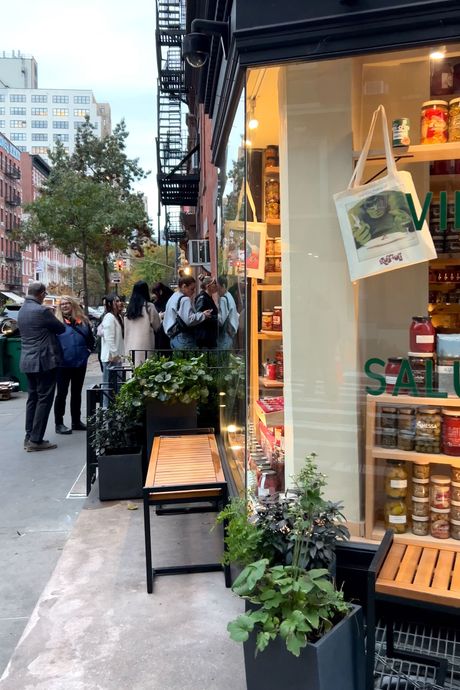If you know an American who has been to Rome, you know an American who has been to Roscioli. Nearly every Yank I spoke to about the Italian import immediately glazed over with rapture, remembering a trip to the Eternal City and a meal at the little salumeria on the Via dei Giubbonari that transforms, with the addition of a few tables in the afternoon and again in the evening, into a restaurant. It is a “deli with kitchen,” according to the Roscioli family who runs it, and for those who long for la dolce vita among the culatelli, it is a must-visit.
So too for those who long for la dolce vita in our less eternal city. Roscioli arrived on American shores this past summer, the first satellite beyond Rome, where the Rosciolis have not only their deli but also a bakery and their wine bar. The salumeria Americana is on a charming corner in Soho, where guests can once again eat among the shelves of Campanian tomatoes and Sicilian capers. And like its Italian cousin, Roscioli NYC has drawn American crowds.
The first night I went, 40 people buzzed about the corner outside, waiting eagerly to be let in for their dinner reservation. (Jessica Chastain — as good an ambassadress as this new Roscioli could want, being American by affect and Italian by marriage — was shown quickly to her table.) The New York restaurant is divided into two parts: a street-level alimentari and a downstairs tasting room, where a fixed four-course menu with wine pairings is served twice each night. Reservations are scarce; on a recent Monday, a server confided that there were 1,200 people on the wait list. Our own trio of upstairs bar seats had been secured by showing up at 4:37 p.m. (the restaurant’s first seating is at 5:30), only to find ourselves second in line.
All of which is to say the cuisine of Roscioli, at least at present, takes a back seat to the experience of Roscioli. It is a pilgrimage in Rome and a pilgrimage in New York, the rare opportunity to dream the same dream twice. But there is better Roman food to be had in New York, and there has been for years. Since the glory days of Sandro’s and Lupa, the latter on the cusp of its 25th anniversary, through the peregrinations of Danny Meyer’s Maialino (reportedly coming back, again, to the Gramercy Park Hotel), Roman cooking has long maintained a foothold here; at Cacio e Pepe on Second Avenue, the namesake dish is still operatically tossed in its hollowed-out tire of Pecorino. We have plenty of good Roman — we even have Bad Roman. There is also plenty of Italian deli. While import restrictions on raw-milk cheese still dog us all, it’s no longer rare to find good-quality olive oil or mascarpone, as it was when Dean & DeLuca began selling them in the late ’70s. The city is home to multiple Little Italys and two giant Eatalys, but you needn’t bother going if they aren’t convenient; my local Brooklyn Heights corner store, which claims no derivation from old Latium, stocks Italian canned tomatoes and salt-packed capers. But then, what Roscioli is offering, in its branded, make-your-own-carbonara kits, isn’t even really groceries; these are souvenirs.




Photos: Hugo Yu.
Photos: Hugo Yu.
The Rosciolis no doubt know how ingrained Italian eating is in New York. Nevertheless, the à la carte menu has the feel of a tourist primer, a greatest hits of Roman cuisine. Among the fritti are crunchy, egg-shaped supplì — Rome’s answer to Sicily’s arancini — filled with rice, tomato, and braised oxtail, and a scamorza in carozza that tastes like a deep-fried, anchovy-perfumed grilled cheese. Three of Rome’s best-known and best-loved pastas (cacio e pepe, carbonara, and amatriciana) are among the primi. The amatriciana — al dente tubes of mezze maniche in a tomato sauce with charred, smoky little nuggets of cured jowl — was fine. But the cacio e pepe, a dish that has had such a latter-day vogue that it has been metamorphosed into fritters, cocktails, and God knows what else, was a mess with a hummus-thick sauce and a mystifying lack of pepe.
The deli of it all dictates much of the menu with much coming from a case or a cask: salumi, cheese, cold tuna and seafood, and an impressive array of vegetables sott’olio, including the bitter Roman favorite, puntarelle, which is surely due for more of a revival than it has yet received in our chicory-mad moment. There are five different preparations offered for burrata — meaning five different things offered with, around, or on top of burrata (sun-dried tomatoes, Cantabrian anchovies, fried zucchini, prosciutto di Parma, and, for good measure, caviar). Among the more involved secondi was a nice hefty porchetta, and in the abdication of the great chef Sara Jenkins, our local porchetta whisperer, it will do. For reminiscing vacationers, basking in the theater of the experience should be enough. Everyone else may be left wanting.
Downstairs, at least for those able to secure a velvet banquette, or a spot at the half-moon communal table, the going gets better. At $130 per person, including wine, it is a deal. The night I visited, there was panzanella, amatriciana, a single polpetto on a cloud of polenta, a slice of tiramisu, and a cannolo accompanied by a quartet of Italian wines poured with a steady hand and a ready story by Lindsay Gabbard, an American-born sommelier and the co-owner of Rimessa Roscioli, visiting from Rome. A Champagne-style sparkler from the south, she informed us, was the last of a final stash, made from Asprinio grapes whose vines grow so high that they could only be picked by ladder — until the picker developed vertigo and huge winds knocked everything over. So ended 350 years of Campanian wine-making. Not all terroir is made to travel.
See All
